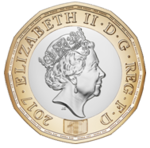United Kingdom | |
| Value | £1 |
|---|---|
| Mass | 8.75 g |
| Diameter | 23.03–23.43 mm |
| Thickness | 2.8 mm |
| Edge | Alternately milled and plain |
| Composition | Outer ring: Nickel-brass (76% Cu, 20% Zn, and 4% Ni) Inner planchet: Nickel-plated alloy |
| Years of minting | 2016–present |
| Obverse | |
 | |
| Design | Queen Elizabeth II |
| Designer | Jody Clark |
| Design date | 2016 |
| Reverse | |
 | |
| Design | Rose, leek, thistle, and shamrock encircled by a coronet |
| Designer | David Pearce |
| Design date | 2016 |
The British one pound (£1) coin is a denomination of sterling coinage. Its obverse bears the Latin engraving ELIZABETH II D G REG (Dei Gratia Regina) F D (Fidei defensor) meaning, 'Elizabeth II, by the grace of God, Queen, Defender of the Faith'.[1][2] It has featured the profile of Queen Elizabeth II since the original coin's introduction on 21 April 1983.[3] Four different portraits of the Queen have been used, with the latest design by Jody Clark being introduced in 2015. The design on the reverse side of the current, 12-sided coin features four emblems to represent each of the nations of the United Kingdom — the English rose, the leek for Wales, the Scottish thistle, and the shamrock for Northern Ireland, also two or three oak leaves — emerging from a single 5-branched stem within a crown. In May 2022 the Royal Mint announced that the Kenyan-born artist Michael Armitage is designing a new £1 coin which will be issued in 2023 and will celebrate the "history of the UK in the 21st century".[4]
The original, round £1 coin replaced the Bank of England £1 note, which ceased to be issued at the end of 1984 and was removed from circulation on 11 March 1988, though still redeemable at the bank's offices, like all English banknotes. One-pound notes continue to be issued in Jersey, Guernsey and the Isle of Man, and by the Royal Bank of Scotland, but the pound coin is much more widely used. A new, dodecagonal (12-sided) design of coin was introduced on 28 March 2017[5] and both new and old versions of the one pound coin circulated together until the older design was withdrawn from circulation on 15 October 2017. After that date, the older coin could only be redeemed at banks,[6] although some retailers announced they would continue to accept it for a limited time,[7] and they remained in use in the Isle of Man.[8]
The main purpose of redesigning the coin was to combat counterfeiting. As of March 2014 there were an estimated 1,553 million of the original nickel-brass coins in circulation,[9] of which the Royal Mint estimated in 2014 that just over 3% were counterfeit.[10][11] The new coin, in contrast, is bimetallic like the current £2 coin, and features an undisclosed hidden security feature called "iSIS" (Integrated Secure Identification Systems).[12][13]
The current 12-sided pound coins are legal tender to any amount when offered in repayment of a debt; however, the coin's legal tender status is not normally relevant for everyday transactions.
- ^ "No. 39873". The London Gazette (11th supplement). 26 May 1953. p. 3023. Proclamation of 28 May 1953 made in accordance with the Royal Titles Act 1953.
- ^ "Project Britain-British Coins". 2013. Archived from the original on 22 October 2016. Retrieved 27 October 2016.
- ^ "One Pound Coin". Royal Mint. Retrieved 22 November 2016.
- ^ Smith, Charlotte (11 May 2022). "New £1 coin to be released in 2023 which will celebrate 'history of the UK in the 21st century'". Manchester Evening News. Retrieved 12 June 2022.
- ^ "New 12-sided pound coin to enter circulation in March". BBC News. 1 January 2017. Retrieved 2 January 2017.
- ^ Giedroyc, Richard (23 May 2017). "'Most secure coin in world' launched". numismaticsnews.net. Retrieved 24 May 2017.
- ^ "Race on to spend old £1 coins as deadline looms". BBC News. 13 October 2017. Retrieved 14 October 2017.
- ^ "Manx round pound coins to remain 'legal tender'". BBC News. 7 February 2017. Retrieved 6 October 2017.
- ^ "Mintage Figures". Royal Mint. Retrieved 28 December 2015.
- ^ "£1 Counterfeit Coins". royalmint.com. Retrieved 1 September 2014.
- ^ "How can I spot a fake £1 coin?". The Telegraph. London. 19 March 2014.
- ^ "New pound coin: Firms told to prepare for redesign". BBC News. 31 October 2016. Retrieved 31 October 2016.
- ^ "Specification of the £1 coin: a technical consultation" (PDF). HM Treasury. September 2014.